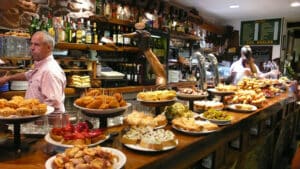Spain is famous for its food – from paella and gazpacho to Spanish tortilla and chocolate-dipped churros – but there’s one dish that offers a taste of the country’s culture as well.

Tapas originated in Andalucía, a Southern province of Spain. The word “tapa” translates as “cover”. Tapas traditionally may have been a complementary piece of sliced ham served on top of a glass of wine, but we know them today as small portions of food commonly served as a snack before lunch or dinner. Tapas can be as simple as a bowl of olives or more hearty, such as slices of Serrano ham.
The history of Tapas
There are a lot of different stories surrounding the origin of tapas. Some people say the creation of tapas was in the 13th century by King Alfonso X of Castile. While recovering from an illness, the King could only eat and drink in small amounts. After regaining his health, he made a decree that all drinks should be served with something to eat.
One popular story is that King Alfonso XIII travelled to Cádiz and stopped at a tavern on a windy day. In order to keep the dust and sand out of the King’s drink, the bartender put a slice of ham on top. The King loved this so much he ordered another drink. Some people will also say tapas were created to hide the bad smell of a cheap wine or to keep out pesky flies.
Another similar story is that lower class workmen would spend their salaries on alcohol rather than food, getting drunk and rowdy in the process. In order to keep things in hand, the King decreed every cup of alcohol must be served with a plate of food. No matter which story you believe, we can all agree that tapas are delicious!
Famous Tapas dishes
Spanish Omelette: Spanish Omelette is made with eggs and potatoes, sometimes also with onion, cooked in a oil.
Patatas Bravas: Typically consists of white potatoes that have been cut into irregular cubes, then fried in oil and served warm with a sauce.
Cured Ham: Slices of the famous Spanish ham is delicious and makes the perfect appetiser before enjoying a paella or other hot tapas dishes.
Calamaria: A firm favourite among the public, delicious calamari is lightly battered and is left a lovely golden brown. Often enjoyed with a dip and is perfect to enjoy with a glass of Spanish wine.
Croquettes: Warm & mouth-watering Jamon Serrano croquettes with manchego cheese will leave your taste buds tingling.
5 places to try authentic Tapas in Spain:
Bilbao
You won’t find tapas bars in Bilbao – instead, you’ll find them serving pintxos (pronounced ‘pinchos’), which comes from the word for ‘spike’, aka the toothpick that holds these ingredients together before they are placed on top of a piece of bread. Most famous is the ‘gilda’, made up of a spicy green pepper, anchovy and an olive, said to have been invented at the Casa Vallés bar in San Sebastian – another Basque city that’s known for its tapas – and named after the character played by Rita Hayworth in the 1946 film. Admire the Art Deco architecture and stained glass of the waterfront Ribera Market, before tucking into a tour of its food stalls and booths, where you’ll see piles of glistening gildas alongside croquetas de bacalao (cod croquettes) and deep-fried idiazabal (sheep’s) cheese unique to the region – best enjoyed with a glass of the local white wine, txakoli.
Granada
Set at the foot of the Sierra Nevada mountains in a region known for its abundant produce, yet only an hour from the Mediterranean coast, this Andalusian city brings the best of both land and sea to its renowned foodie scene. Not only do most places still uphold the tradition of a free tapa with each drink – sadly not a given across many other Spanish cities these days – but you can also pick up on the region’s Arab influences in its cuisine. It was the last region to be ruled over the Moors until the late 15th century, resulting in dishes rich with spices such as cumin, coriander and nutmeg. You’ll find plenty of fried sardines and anchovies, fresh Andalusian gazpacho, grilled sausage and local specialities like ham and beans, San Antón stew and – not for the faint-hearted – the Sacromonte tortilla (omelette) which includes calf and pig’s brains and testicles, so only order if you dare. Follow local residents on the many tapas routes around the city, with plenty of options around Plaza Nueva and Plaza Campillo or along the bar-filled streets of Calle Navas or Calle San Mateo.
Valladolid
Less than an hour from Madrid by high-speed train sits the 17thcentury Spanish capital of Valladolid, a hotbed of historic palaces, sweeping plazas and galleries, including the National Museum of Sculpture and the home of Don Quixote writer Cervantes. Each November, it’s also home to an annual tapas competition bringing together chefs from around the world to compete for both national and international titles, and prompting every bar with a tempting tapas menu to up its game. The region is known for its hearty meat dishes, so you’ll find top-quality Iberico ham and morucha beef from Salamanca in charcuteries like Jamonería Sarmiento, which converts into a tapas bar after dark; in the bars around Plaza San Martín and Plaza Martí y Monsó; or from the local producers in Mercado del Val, a late 19th-century iron-built market near the grand church of San Benito el Real. Or come for the festival, when creative culinary talents stretch the definition of tapas as far as it can go with fusion ingredients from all over the world.
Las Palmas
The Gran Canarian capital’s old town of Vegueta is a twisting maze of cobbled streets overlooked by brightly coloured buildings and wrought-iron balconies, centred around the grand Catedral de Santa Ana and home of Christopher Columbus, Casa de Colón. On a Thursday evening, people spill out from the bars along Calle Mendizábal and the old town’s array of pedestrian plazas on a pincho crawl, where a drink and a single serving should set you back less than €3. Alternatively, dine under the arches of the city market Mercado del Puerto, a Modernist structure designed by French engineer Gustave Eiffel, where you can pick up tempting bites from different stalls – each with its own speciality, from sheep’s cheeses to local cured meats – then perch at its tall tables to wolf them down. Expect mainland Spain classics alongside the Canary Islands’ signature papas arrugadas (wrinkled potatoes) with red and green mojo sauces.
Logroño
La Rioja region might be best known for its eponymous wines, but its tapas game is top-notch too, not least in capital Logroño. In the heart of its medieval old town, Calle Laurel and its surrounding streets bring together dozens of bars and restaurants dishing out delicious pinchos each night, so you could spend an entire evening hopping from one spot to the next and still have to come back several times to try them all. Each place has its signature dish featuring local specialities like white asparagus, sun-ripened peppers, garlic-infused mushrooms and regional favourite patatas a la riojana which mixes in paprika-spiced chorizo. You’ll find the spicy sausage in every form, but the simplest and best is chistorra, or grilled chorizo with paprika and garlic.
(Article source: Various)

